McLaren, Aston Martin, Ferrari and the cars to collect in 2024
With the end of the internal-combustion era approaching, the supercars of 2024 are all likely to become collectable, so let us help you decide which one to invest in.
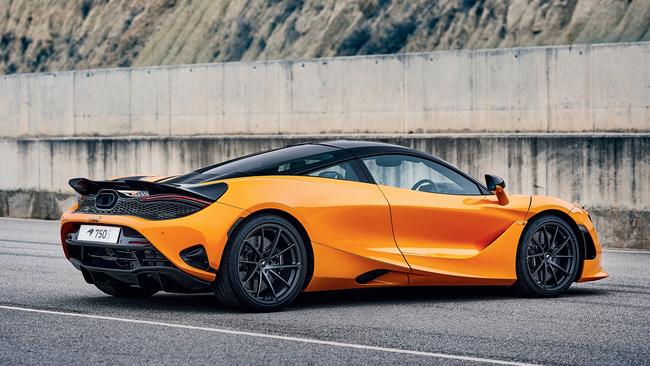
Strap yourself in - here our Top 7 super hero cars ...
McLaren 750S
If you want to create a truly bonkers supercar, it always helps to start with a vehicle so unhinged that it looks as though it should be parked in a padded cell rather than a garage.
In this case, that starting point was the McLaren 720S, with its twin-turbocharged V8 engine, spine-realigning acceleration, and an approach to keeping its kilograms down every bit as extreme as a boxer cutting before a weigh-in. But what many saw as a benchmark supercar now pales in comparison to this new McLaren 750S, which is lighter, faster, angrier and more powerful – and not just by a little bit.
Home to the most potent V8 engine ever stuffed into a series McLaren, the 750S produces a hefty 552kW and 800Nm. On their own, they are big numbers, but when combined with the 750S’s feather-light 1389kg kerb weight (which is on par with a Toyota Corolla Hybrid, by the way), the results are astonishing.
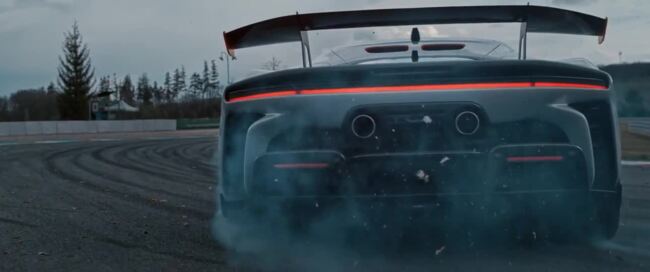
McLaren says the 750S will see even the most ham-fisted of drivers clip 100km/h in 2.8 seconds. Even more impressive is the fact that 200km/h will arrive in just 7.2 seconds, and that the 750S will keep climbing to somewhere north of 350km/h. When it comes time to stop, a combination of carbon ceramic brakes and an active rear wing that doubles as a jet fighter-style air brake should see you decelerating so savagely it will feel like you’re reversing the rotation of the Earth.
How much for this brutal, exhilarating drive experience? The McLaren 750S is yours for $585,800. And there is one more reason you should pop this mad-house McLaren on your shopping list. The brand is being shy on the details, but it’s very, very likely that this will be the last non-electrified V8 engine you’ll ever find in a series McLaren. Get it while you can then, and maybe store it in a padded garage; its value is only going to climb.
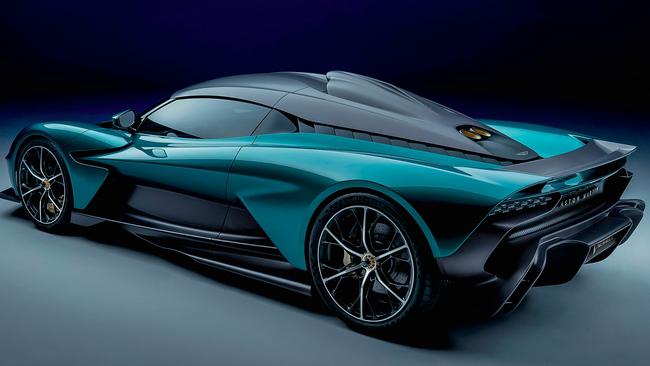
Aston Martin Valhalla
If Aston Martin was a human – and if it was it would definitely look like Sean Connery in his early 50s, with a dash of David Beckham’s style – people might be a little bit concerned that it/he is having a midlife crisis. To be fair, for a brand that’s more than 100 years old, it’s probably overdue.
The clue to the crisis comes in the alarming shape of the Aston Martin Valhalla (even the name is unusually otiose for Aston). After making a living selling front-engined grand tourers, and we do mean genuinely grand, Aston Martin decided a few years ago that it wanted to get into the mid-engine supercar business.
So, the brand joined forces with the Red Bull Racing Formula One team, developed the most extreme hypercar on the planet (the Valkyrie) and then went out and started its own F1 team. All of this was either to prove its credibility to the world’s wealthy supercar clientele, or because it was starting to worry how old it looked in the mirror.
The Valhalla is the car Aston Martin wants those rich, F1-watching supercar lovers to actually buy. Less highly strung than the limited-edition Valkyrie – which should really only be driven by professional lunatics – the Valhalla is still an impressive machine. The engine in the middle is the same AMG-built 4.0-litre twin-turbo V8 found in its GT cars, but it’s assisted by a pair of electric motors to make 698kW of power and a neck-snapping 1000Nm of torque.
But that’s only part of the story, because like all good, modern supercars, the Valhalla can be green – and we don’t just mean the brand’s famous colour. The electric motors, with one mounted on each axle, can motivate this supercar without any petrol-burning help for up to 15km and up to speeds of 130km/h. Once the petrol engine is engaged, Aston Martin claims it will run all the way to 330km/h and take just 2.5 seconds to run 0–100km/h.
By mounting the V8 behind the driver instead of ahead of them, the Valhalla (estimated price around $1.8 million) should be the best-handling member of the Aston Martin line-up and give the brand’s F1 rivals – Ferrari, McLaren and Mercedes-AMG – a run for their money in the supercar sales race as well.
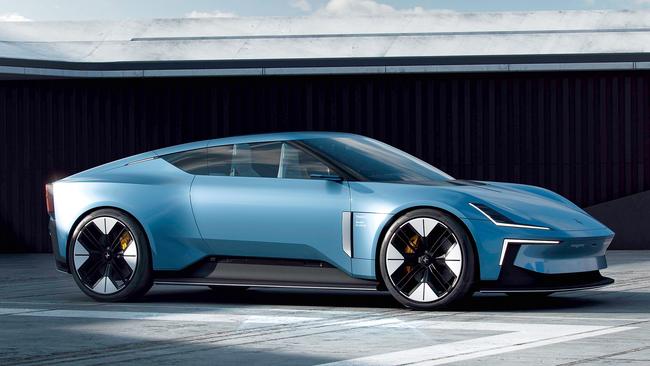
Polestar 6
If I had a dollar for every time a brand said it was going after Porsche, I’d have … well, not that many dollars, actually. Most brands are smart enough to know that calling out Stuttgart’s finest only welcomes comparisons that rarely end well. Possibly never, in fact.
Still, it does happen, and most recently with Chinese-Swedish EV maker Polestar, which began life as Volvo’s performance arm before striking out on its own as an electric-vehicle specialist. The brand is currently working on a pair of flagship performance twins, the hard-top 5 and its stunning open-topped sibling, the 6 – and it is making no secret about what it sees as the target.
“We’re certainly targeting the Porsche Panamera, the Porsche Taycan – we have these products firmly in our crosshairs,” says Steve Swift, head of vehicle engineering at Polestar UK.
“This is a very high-performance offering, but it’s one that still has the luxury you’d expect from a long-wheelbase GT. Plus it’s mixed with the vehicle dynamics of a shorter, more agile car.
“It hasn’t been a walk in the park. But it can be done.”
This is what Polestar refers to as its “manifesto vehicle”. While all of its cars to date have been built on existing platforms, the 5 and 6 have been developed from a blank sheet of paper at an engineering skunkworks in the UK, where engineers from McLaren, Lotus and several F1 teams have been applying their know-how to a new bonded aluminium space-frame chassis that is very stiff, and very light.
The Polestar 5 will go into production next year, with the P6 to follow, and while some details are being kept under wraps, we do know it will debut an 800-volt architecture, and be offered in dual-motor (think more than 500kW) or single-motor (around 400kW) guises. It should also be home to a massive 100kWh battery pack, which should mean a driving range of around 600km between charges.
Expect pricing to start north of $280k. Oh, and we’ve taken a very smoky, very sideways passenger lap in one of the brand’s development cars, and on first, white-knuckle impressions, Porsche might find itself looking over its shoulder.
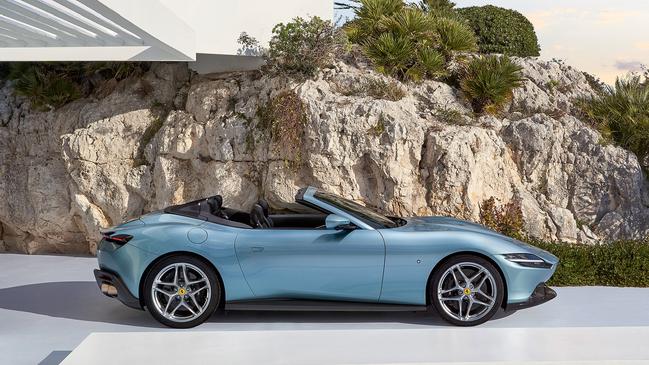
Ferrari Roma Spider
Ferrari is at its best when it’s making the hardest, fastest, most extreme vehicles it possibly can. Where the results are always a little more mixed, however, is when the Italian icon turns its attention to softer, more accessible vehicles. Exhibit A would be the Ferrari California, a relatively affordable, slightly soft convertible that was hardly the most celebrated vehicle in the Prancing Horse stable.
The brand got it right with the Roma, though, a sleek and endlessly stylish “entry-level” supercar designed as a homage to the old days of Rome, when fashion was elegant rather than arrogant and wealth was understated rather than shouty.
The incoming Ferrari Roma Spider — the first front-engined convertible produced by the brand in 50 years — is the next chapter in the Roma story, and it is genuinely stunning, somehow looking lower, sleeker and sportier than its hard-topped sibling, whether the top is open or closed.
Speaking of its roof, the electric soft-top can retract in just over 13 seconds, and at speeds of up to 60km/h, which is helpful should you suddenly find yourself under a rain cloud, or driving through some smog-filled tunnel. Elsewhere, this is the Roma we’ve come to know and love, including its 3.9-litre twin-turbo V8, which generates a sizeable 456kW and 760Nm. The sprint to 100km/h takes just 3.4 seconds and the top speed is a claimed 320km/h, which will surely make you feel like you’re skydiving should you attempt it with the roof open.
Pricing is yet to be confirmed but the Roma Coupe starts at $409,888 in Australia, which would suggest that feeling the wind in your hair will carry a price tag closer to half a million.
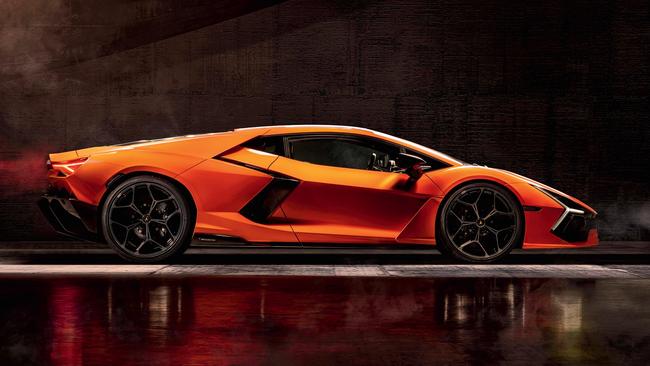
Lamborghini Revuelto
Let me share a little secret with you. I know that, in the near future, I’m going to be invited to fly somewhere lovely to drive the new Lamborghini Revuelto, and that while I’m there I’ll try very hard not to snigger about how silly its name is (apparently it means “scrambled” or “mixed”, and is not Italian for “revolting”), but I will also be just a little bit frightened.
That’s because the car it replaces, the Aventador, was already just a little terrifying, and yet Lamborghini has decided it should be far more powerful and is hyper-hybridising its already vicious V12 by adding three electric motors. The result will be a car that offers more than 1000 horsepower, and delivers it with the instantaneous low-down brutality of an electric car, before the V12 kicks in to add some old-school howling madness as it rushes towards a top speed “in excess of 350km/h”.
The numbers sound like a warning to wear brown pants while driving it, with 757kW (the old one would rip holes in the road with “just” 544kW) and 725Nm of torque. The 100km/h mark will blast past you in fewer than 2.5 seconds and you’ll be doing 200km/h in less than seven seconds.
Apparently a lot of Australians are braver than I am because the brand has been swamped with orders for Revuelto and there is already a two-year waiting list. The first cars will arrive here in the first quarter of 2024, and while pricing has not been confirmed, it’s very likely to be north of $1 million (the Aventador was close to $800k, but it looks like a bit of a slug compared to Revuelto).
Lamborghini isn’t expecting too many trade-ins either, because the outgoing Aventador, the last naturally aspirated “pure V12” the company will ever make, is going to be a collector’s item. And why have just one terrifying Lamborghini when you could have two?
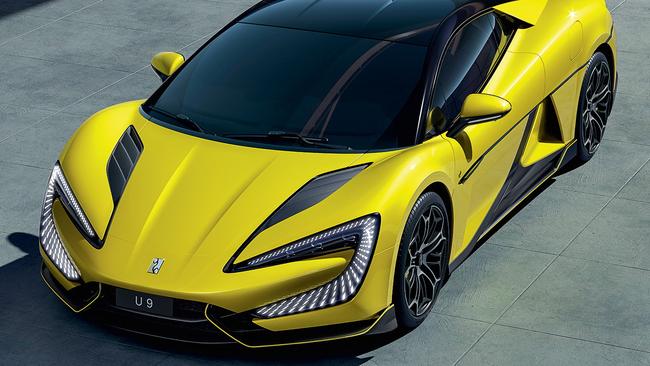
BYD Yangwang U9
Think Chinese electric vehicles are all about the budget-friendly A to B? Perhaps the BYD Yangwang U9 will change your mind. Yes, BYD – or Build Your Dreams – is the maker of the mega-popular Atto 3, and it will soon sell Australia’s cheapest EV in the Dolphin, which will start at less than $40k, but it’s fair to say the Yangwang U9 lives at the opposite end of the brand’s EV spectrum.
It will be expensive for a BYD, but it could be something of a supercar bargain in Australia, where – based on Chinese pricing – it could start below $250,000. Yangwang is BYD’s luxury spin-off, and the U9 is promising a ferocious quad-motor setup, with a powerful electric motor positioned at each wheel, which should deliver a sprint to 100km/h in just two seconds flat. That’s very, very fast, Ferrari-embarrassing fast and almost a full second quicker than the McLaren 750S, which just goes to show the scenery-tearing performance unlocked by electrification (putting a motor on each wheel, when most EVs make do with two, or even one, helps).
We don’t know yet exactly how powerful the U9 will be, but other quad-motor models in the Yangwang stable produce – wait for it – 820kW and 1280Nm, which would make this Chinese super-EV among the most powerful models in this list.
And there are other party tricks up its sleeve, too, including the unusual ability to jump – as in, lift all four wheels off the ground at once from a standstill. That comes courtesy of the U9’s Intelligent Hydraulic Body Control System, which will also allow it to drive on three wheels, should one of the four fly off for some reason.
We don’t know yet if, or when, the U9 will make it to Australia, but with BYD models now flooding our shores, it looks more likely than ever.

DeLorean Alpha5
Here’s an exclamation you don’t hear enough anymore: “Great Scott!” And here is the car associated with that line, shouted repeatedly by Doc Brown in the wonderful Back to the Future movies: the DeLorean, a vehicle that was actually a bit of a disaster in the real world but which holds a place in many hearts due to its role as Michael J Fox’s time machine.
Happily, the long-buried marque (the DeLorean DMC-12 was the ill-fated brainchild of one-time Pontiac engineer John DeLorean) is back, and the new one has very little in common with the original, aside from its famous name. Instead, as with many car revivals, a recognisable name is being used to help sell another all-new electric vehicle in the hope of attracting attention – and possibly credibility.

This new DeLorean Motor Company is what you expect of a modern start-up EV brand, with a website heavy on words such as “iconic”, “reimagine” and “rebellious”, just to underline how edgy and non-conformist it is. But if you look beyond the buzzwords, the new DeLorean, dubbed the Alpha5, sounds genuinely exciting.
The company claims it will feature a 100kWh battery and offer a driving range of more than 480km, with a top speed of 250km/h, as well as being capable of firing from 0–88mph (or 142km/h, the number being a clear nod to the film series) in just 4.3 seconds. Fingers crossed they actually get it into production in 2024, as hoped, because it’s probably getting to that time when Hollywood decides to reboot the Back to the Future series, and they’ll need a new time machine.
This story appears in the October issue of Wish Magazine, out now.




To join the conversation, please log in. Don't have an account? Register
Join the conversation, you are commenting as Logout